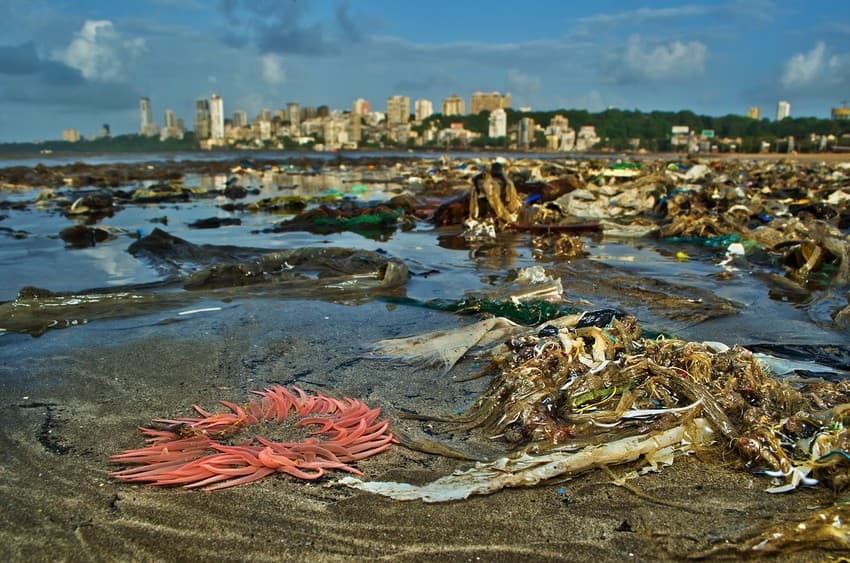It permeates our world, it will outlast us
Bright red anemone, bright blue polythene; white squid egg-cases, white sachets of gutka tobacco; red carapace of an egg crab, red crushed cola can. These juxtapositions are neither staged nor imagined. These are real shore walk observations from my notebooks. I have seen a dazzling diversity of intertidal marine life, mostly on the polluted, yet unimaginably biodiverse shores of Mumbai, the crowded metropolis by the sea.

Photo: Rizwan Mithawala
Intertidal fauna, if one develops the eye for them, are quite colourful: sponges in all hues one can imagine, porcelain crabs in pink-white pinstripes, blue bottles (a colonial organism composed of several individual animals called zooids, also known as the Portuguese Man O’ War) a deep blue, blue buttons (yet another colonial organism composed of polyps specialised for feeding, defence, and reproduction) a brilliant turquoise. Equally colourful is the plastic trash that smothers the shores. As a shore walker, I have often wondered whether a pink glob is a sea anemone or a fake flower from a discarded plastic garland, whether that blue bit is a piece of polythene or a Portuguese Man-O-War.
Spotting anemones and other marine animals amidst plastic litter is an experience both overwhelming and enlightening. We have smothered the Earth’s land and water surfaces with plastic. “If all the plastic made in the last few decades was cling-film, there would be enough to put a layer around the whole Earth. With current trends of production, there will be the equivalent of several more such layers by mid-century,” said Jan Zalasiewicz, Professor of Palaeobiology at the University of Leicester, in a press release dated January 2016.
But plastic is not just on the surface; it is running deep, as explained in a review paper by Zalasiewicz and others titled ‘The geological cycle of plastics and their use as a stratigraphic indicator of the Anthropocene’ published in the journal Anthropocene, in March 2016. Our excessive dependence on plastics, their indispensability in our lives, and their disposability, have given them ubiquity – they are now everywhere, from mountaintops to the ocean floor. And they are here to stay. Their distribution in both terrestrial and marine environments, suggests the study, makes them a key geological indicator of the Anthropocene, as a ‘distinctive stratal component’.
When buried and beyond the reach of ultra‐violet light from the sun that can break the bonds in their chemical structure, causing them to become brittle and then fragment, plastics are long‐lived on human time‐scales, explains the paper. In colder temperatures within the deep ocean, beyond the reach of UV light, they are likely to last for ‘centuries to millennia’. Especially in marine sediments, explains the paper, microplastics form widespread markers, very similar to microfossils in conventional palaeontology.
“Once buried, being so hard-wearing, plastics have a good chance to be fossilised, and leave a signal of the ultimate convenience material for many million years into the future. The age of plastics may really last for ages,” says Zalasiewicz.
The sandy banks of the creek where Mumbai’s Mithi River meets the sea – carrying sewage and industrial waste – are unusually colourful: all plastic, very little visible sand, and no anemones! One evening, standing on plastic bag stuck deep in the bank, stomping on it to feel the sand underneath, I tried, in vain, to pull out a sheet of plastic from the sand. My friend Kaustubh from the nearby koliwada (fishermen’s colony), who was accompanying me, laughed and said, “I have made sand castles here in my childhood. There was enough sand then.” He told me that the plastic sheet I was trying to pull would be removed by the excavators of the municipal corporation. Feigning relief, I looked at the many pieces that were entering the Arabian Sea, and hoped that they don’t choke sea turtles, and settle deep in the sediment.
——————————————————————————————————————————————————————
About the author: Rizwan Mithawala is a Conservation Writer with the Wildlife Conservation Trust and a Fellow of the International League of Conservation Writers. He has previously worked as an environment journalist with a national newspaper.
Disclaimer: The author is associated with Wildlife Conservation Trust. The views and opinions expressed in the article are his own and do not necessarily reflect the views and opinions of Wildlife Conservation Trust.
——————————————————————————————————————————————————————
Your donations support our on-ground operations, helping us meet our conservation goals.
——————————————————————————————————————————————————————
Related Links
- World Wildlife Day 2019 – Life Below Water
- Amputees of the Anthropocene
- Porpita porpita – Holding a Mirror to Mankind
- Fish Out of Water – One Too Many
- Status of humpback dolphins and finless porpoises
- Kanhargaon is state’s 50th wildlife sanctuary

